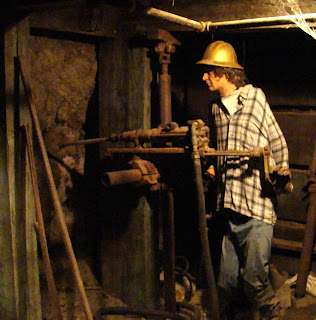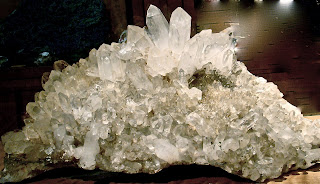

 The Fricot Nugget (pictured right) weighs thirteen pounds and is one of the finest and largest examples of crystal-lized native gold in the world. It is the largest surviving specimen from California’s Gold Rush era and can be seen in the vault at the California State Mining and Mineral Museum in Mariposa.
The Fricot Nugget (pictured right) weighs thirteen pounds and is one of the finest and largest examples of crystal-lized native gold in the world. It is the largest surviving specimen from California’s Gold Rush era and can be seen in the vault at the California State Mining and Mineral Museum in Mariposa.
It was discovered in 1865 near Georgetown in my home of El Dorado County. It changed hands numerous times, then disappeared in 1878. It was found in 1943 in a safe deposit box in Angels Camp, CA (home of the Jumping Frog of Calaveras County,) by the bank manager. Marie E. Benton – owner of the nugget – was persuaded to donate it to the California State Gem and Mineral Collection in memory of her father, Jules Fricot.
Sadly, the Fricot Nugget is once again getting ready to do a disappearing act. My visit on May 10 found the museum already packing their contents for shipment to a warehouse in Sacramento, in preparation for the July 1 closure. Artifacts will be stored there until money is once again available for the parks to re-open. In other words, maybe never.
 The mineral collection began in 1880, and now contains over 13,000 objects including mining artifacts, crystalline gold, and thousands of beautiful gems and mineral specimens from California and around the world. The collection was moved to the Mariposa Fairgrounds in 1983 after residing in San Fran-cisco's Ferry Building for over 80 years. The museum became a state park in 1999.
The mineral collection began in 1880, and now contains over 13,000 objects including mining artifacts, crystalline gold, and thousands of beautiful gems and mineral specimens from California and around the world. The collection was moved to the Mariposa Fairgrounds in 1983 after residing in San Fran-cisco's Ferry Building for over 80 years. The museum became a state park in 1999.

On this gorgeous mid-May morning I drove 3-1/2 hours down the always beautiful and historic Golden Chain Highway 49 from Placerville to Mari-posa. I arrived at the Fairgrounds and had a quick picnic lunch near a gazebo that had been taken over by Barn Swallows.
There were of course, no wildflowers at this State Park, but rather, rocks in their pure, uncut forms providing the full spectrum of color and texture.



While gazing at a large, magnificent Amethyst, I learned that the Greek word "amethystos" means "not drunken." The ancient Greeks believed if you dropped an Amethyst into your wine you would not get drunk. I made a mental note to keep Amethysts far away from my wine bottles at home.


School children on field trips fill the museum on most week-day mornings, an event that will surely be missed by area students once it is closed.


 With clipboard in hand, the children scramble about the two main galleries, ticking off items on their "Mineral Sca-venger Hunt" list, answering questions like, "What mineral makes crystals like purple squares?", or, "Find the case with rocks from space."
With clipboard in hand, the children scramble about the two main galleries, ticking off items on their "Mineral Sca-venger Hunt" list, answering questions like, "What mineral makes crystals like purple squares?", or, "Find the case with rocks from space."
Practical uses of a given mineral were displayed. A long table with a couple of dozen different rock samples had a "Please Touch" sign. I enjoyed handling the rocks at least as much as the kids did.
A tour guide walks the students through a model of a gold mine. Eyes are given a minute to adjust to the long dark hallway, as they learn of the conditions miners often worked in. Around the bend are exhibits of the different methods used to get the precious ores out of the ground and to the surface.


California has a state flower, (Poppy,) a state animal, (Grizzly Bear,) and a state bird, (Quail,) but I was unaware of our state gemstone: Benitoite. This dark blue
 stone was discovered in San Benito County in 1906. There is no other gemstone quality benitoite in the world. This mine is closed now, making benitoite very rare. The museum gift shop had the tiniest stud earrings ranging from $350 - $750!
stone was discovered in San Benito County in 1906. There is no other gemstone quality benitoite in the world. This mine is closed now, making benitoite very rare. The museum gift shop had the tiniest stud earrings ranging from $350 - $750!

 A re-creation of an 1850's Assay Office, a mining cart tilting on a track overhead, a model of a stamp mill, and a miniature mining town made of petrified wood decorate the final room of the gallery.
A re-creation of an 1850's Assay Office, a mining cart tilting on a track overhead, a model of a stamp mill, and a miniature mining town made of petrified wood decorate the final room of the gallery.
A very practical display showed some of our modern day minerals and how they are used for our everyday items. Mining in general is often depicted as a villain in both human rights and envi-ronmental abuses. Yet the average westerner is estimated to use around 40,000 pounds of newly mined minerals annually, for everything from mirrors to toothpaste, electronics to light bulbs, books, film and soap. I was horrified and vowed to go home and fine at least one or two things I could use less of.
The Mariposa Mining and Mineral Museum has submit a proposal to the state, to be completely run by volun-teers. The proposal as not yet been accepted. The museum is open Thursday through Sunday. With a closure date of July 1, and packing commencing, there are literally only days left to view the Fricot Nugget and her sister gems.

I hope to see you at the State Parks.
Lucy
A lot to say: The pictures you're taking are beautiful and I think the whole idea of your blog is very interesting. I recently made my own blog and stumbled across yours by just cruising randomly and decided to follow because I'm newer to California (2 years) and like to hear about all of my surroundings. Your formatting is really creative also- it looks like a well-made textbook with the picture alignment and all. It must take you a long time to finish each entry with all of those links! Fantastic.
ReplyDeleteIt was a pleasure meeting you. What great pictures you took of the Museum. We will be closing the doors June 30, so please everyone come visit us before we close.
ReplyDeleteInformative article, just what I needed.
ReplyDeleteDolfin Swimwear
My webpage > Dolfin Swimwear